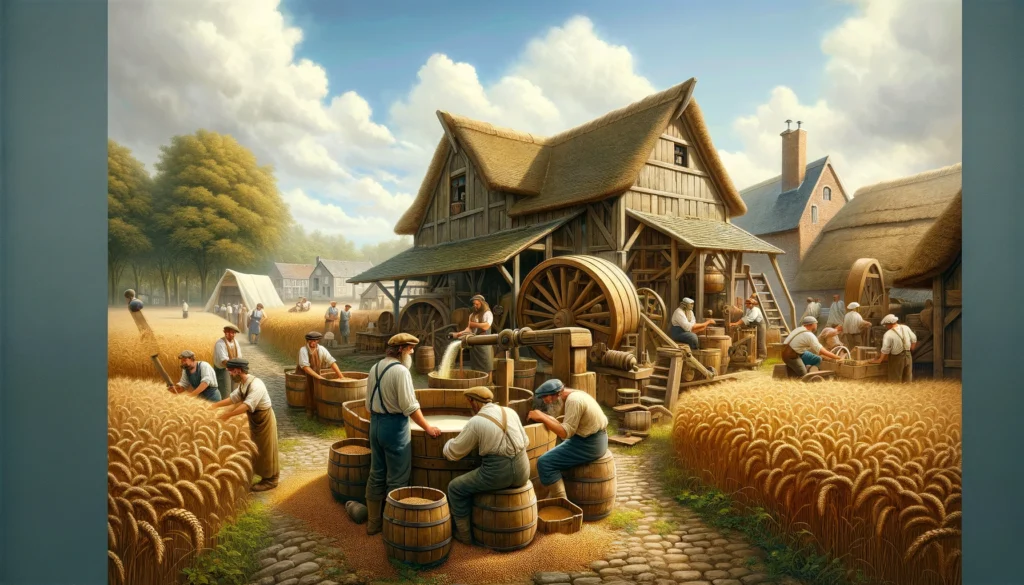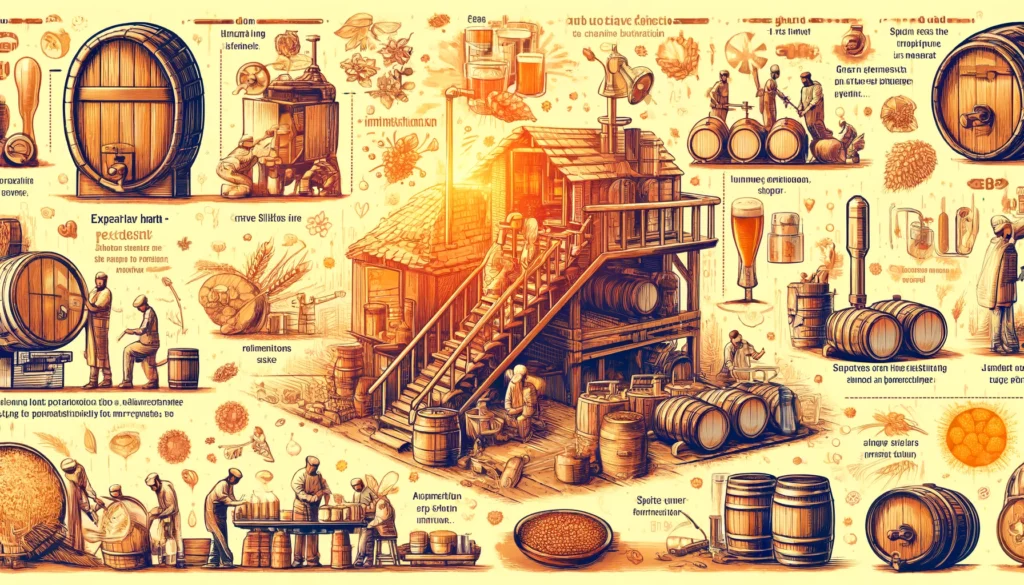Saisons, often known as farmhouse ales, are a unique style of Belgian beer originally brewed on farms for seasonal workers. They are renowned for their dry, fruity, and spicy flavor profile, which comes from distinctive saison yeast strains and warm fermentation temperatures. Historically rooted in rustic Belgian traditions, these ales have evolved to appeal to a wide range of palates.
Today, saisons continue to captivate beer enthusiasts with their effervescent carbonation, peppery notes, and refreshing character. Their versatility and dynamic flavor profile make them a beloved choice for pairing with food or enjoying on their own.
Historical Background
Saisons, known as farmhouse ales, have a rich historical background deeply rooted in the farming traditions of Belgium. Originally brewed on Belgian farms, saisons were crafted to provide refreshing, yet hearty sustenance for seasonal farm workers during the summer. Farmers relied on local grains and distinctive saison yeast strains that could ferment well under warm temperatures, producing a rustic beer known for its dry, fruity, and spicy flavor profile.

Over time, farmhouse ales evolved from a necessity for field laborers to a sought-after style enjoyed worldwide. The addition of unique ingredients, such as different grains, spices, and hops, further diversified their flavor profiles. Variations like Grisette and Brett Saison emerged, highlighting regional differences and creative brewing methods.
In contemporary craft beer culture, the versatility of saisons has cemented their popularity. Brewers experiment with different brewing techniques, yeast strains, and fermentation temperatures to create modern interpretations that still retain the core characteristics of the style. Saisons are now celebrated for their distinctive terroir, refreshing effervescence, and dynamic flavor combinations, from peppery and citrusy to earthy and tart.
Whether enjoyed on their own or paired with food, saisons offer a refreshing and flavorful journey that honors their farmhouse origins while embracing their newfound global appeal.
Brewing Process
The brewing process of saisons reflects the rustic and creative traditions of farmhouse brewing. Each ingredient and brewing step is carefully selected to create a unique, refreshing ale with a dynamic flavor profile. From grains to spices and warm fermentation techniques, these ales achieve a distinctive character that continues to captivate beer enthusiasts worldwide. Below, the main components and steps are detailed:

Ingredients
Saison ingredients include grains, hops, yeast, and spices, each playing a pivotal role in creating a distinctive dry, fruity, and spicy flavor profile. Their careful selection ensures the rustic and complex character of farmhouse ales.
Grains
The foundation of a saison begins with grains, typically barley, but often incorporating wheat, rye, or oats for added body. These grains form the rustic character crucial to farmhouse ales.
Hops
European hop varieties are used sparingly, providing just enough bitterness to balance the fruity, spicy esters produced by the yeast. Dry hopping can also be used to enhance aroma.
Yeast Strains
The distinctive saison yeast strains give these ales their iconic peppery, fruity, and spicy notes. Warm fermentation temperatures lead to high attenuation, resulting in a dry finish.
Spices and Additives (Optional):
Coriander, orange peel, and ginger are frequently added to accentuate the natural esters, lending additional layers of complexity to the flavor.
Fermentation
Saisons are fermented at warm temperatures, often exceeding 80°F, to promote high attenuation and ester production. This fermentation process results in a dry, effervescent beer bursting with the characteristic flavors of a farmhouse ale.
To know more about beer fermentation, read our detailed guide – How Beer is Made: From Ingredients to Fermentation

Carbonation and Aging
Saisons typically undergo bottle conditioning to achieve high carbonation, creating their signature effervescence. Aging also plays a critical role, as maturing the beer over time enhances its complexity. The result is a refreshing, highly carbonated beer showcasing an array of flavors, from fruity and spicy to tart and funky.
This intricate brewing process, guided by unique yeast strains and rustic brewing techniques, ensures that each saison offers a distinctive drinking experience while maintaining the rich tradition of farmhouse ales.
Flavor and Aroma Profile
Saisons are renowned for their dry, fruity, and spicy flavor profile, crafted through unique saison yeast strains and warm fermentation. Key aromas like pepper, citrus, and farmhouse funk lend these ales their distinct personality. The high carbonation provides a refreshing effervescence, while the yeast imparts layers of fruity esters and spicy phenolics that range from subtle to bold.
Saison Variations
Saisons come in various styles, from the lighter Grisette to the wild Brett Saison, each offering distinct flavor profiles. These variations showcase different yeast strains, brewing techniques, and ingredients while maintaining the traditional farmhouse character.
Grisette
This lighter variant was traditionally brewed for miners rather than farm workers. It shares the farmhouse ale character but features a lower alcohol content. Its flavors are more delicate and refreshing, often with a softer mouthfeel and subtle fruit and spice notes.
Brett Saison
The addition of Brettanomyces yeast gives this variation a funky, wild character, offering flavors ranging from earthy and barnyard-like to tart and fruity. It’s a bold and adventurous take on the style, providing beer lovers with a unique tasting experience.
Other Variations
Craft brewers continue to experiment with spiced and experimental saisons. These can include unique ingredients like lemongrass, hibiscus, or different grains and spices to deliver new twists while maintaining the core farmhouse character.
Notable Examples:
- Dupont Saison: Often regarded as a benchmark for the style, it features a peppery, earthy aroma and a fruity, dry finish.
- Hill Farmstead: Their saisons are known for their complexity, often featuring fruity, tart notes combined with hints of oak from aging.
- Brasserie Fantôme: Famous for experimental saisons with diverse and unconventional ingredients, Fantôme produces unique flavor combinations that intrigue beer enthusiasts.
These notable breweries demonstrate the diversity of saisons, whether adhering closely to tradition or pushing the boundaries of farmhouse brewing. Their distinctive takes on the style help define and expand what saisons can be.
Food Pairings
Saisons’ dry, fruity, and spicy flavor profile makes them incredibly versatile for pairing with a variety of foods:
- Cheese: Goat cheese complements the bright, fruity notes of saisons, while other soft cheeses like camembert offer a creamy contrast to their peppery spice.
- Seafood: The effervescence and citrusy character of saisons cut through the richness of mussels and other shellfish, providing a refreshing counterpoint.
- Meat: Grilled sausages or roast chicken pair well with saisons, as their smoky, savory flavors match the beer’s dry, spicy finish, creating a harmonious combination.
FAQs on Understanding Saisons
What makes Saisons taste so spicy and peppery?
The secret lies in the yeast! Saisons are fermented with unique yeast strains that produce peppery phenolics and fruity esters during fermentation. These contribute to the distinctive flavor profile of Saisons.
What’s the difference between a Saison and a regular ale?
Temperature and tradition! Saisons are typically fermented at warmer temperatures compared to most ales. This, combined with the specific yeast strains, leads to their dry, spicy character. Additionally, Saisons have their roots in Belgian farmhouse brewing traditions, often utilizing local ingredients and reflecting rustic brewing methods.
Are Saisons always light and refreshing?
While many Saisons are known for their light body and effervescence, there’s variety! Some Saisons, particularly those aged with Brettanomyces yeast (Brett Saisons), can develop a more complex flavor profile with funky or earthy notes. Additionally, some brewers may incorporate different grains or spices, adding depth and richness to the beer.
What kind of food pairs well with Saisons?
Saisons’ versatility shines here! Their dry, spicy character makes them a great match for a variety of dishes. Consider pairing them with:
- Cheese, Seafood, Grilled meats
Ultimately, experimentation is key! Explore different Saisons and food pairings to discover your favorites.
Conclusion
Saisons are unique and versatile farmhouse ales that capture the rustic charm of Belgian brewing while offering diverse flavor experiences. Their high carbonation, dry finish, and complex blend of fruity, spicy, and earthy notes make them enjoyable on their own or as an excellent accompaniment to food. Modern variations like Grisette and Brett Saison, alongside experimental takes, continue to evolve the style.
Beer enthusiasts are encouraged to explore different breweries and their distinctive interpretations to appreciate the full breadth of flavors that saisons have to offer. Whether you’re a seasoned beer lover or new to farmhouse ales, there’s a saison that will captivate your palate.
Also Read:
Harold Desir is a seasoned beer enthusiast and expert, with over a decade of experience exploring the world of craft beers and brewing techniques. His deep knowledge of beer styles, brewing processes, and industry trends makes him a trusted voice in the beer community. Harold's passion for all things beer is evident in his engaging and informative blog posts, where he shares his insights, reviews, and tips with fellow beer lovers. Cheers!

